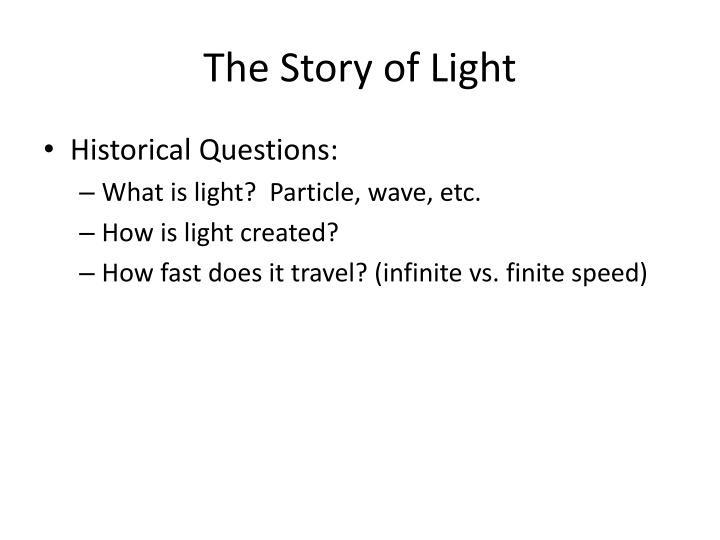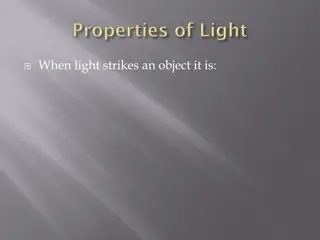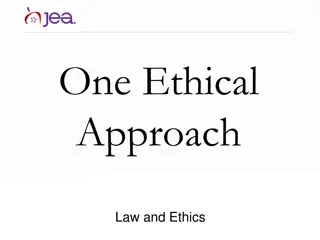The Story of Light: Historical Insights
Delve into the historical questions surrounding light - its nature as a particle or wave, how it is created, and the debated speed of its travel. Explore past theories from renowned thinkers like Empedocles, Plato, Roemer, and more, shedding light on the evolution of understanding light from ancient times to the modern era.
Download Presentation

Please find below an Image/Link to download the presentation.
The content on the website is provided AS IS for your information and personal use only. It may not be sold, licensed, or shared on other websites without obtaining consent from the author.If you encounter any issues during the download, it is possible that the publisher has removed the file from their server.
You are allowed to download the files provided on this website for personal or commercial use, subject to the condition that they are used lawfully. All files are the property of their respective owners.
The content on the website is provided AS IS for your information and personal use only. It may not be sold, licensed, or shared on other websites without obtaining consent from the author.
E N D
Presentation Transcript
The Story of Light Historical Questions: What is light? Particle, wave, etc. How is light created? How fast does it travel? (infinite vs. finite speed)
Intromission vs. Emission & speed of light Empedocles (~450 BC) argued that light was something in motion and took time to travel. Argued light was emitted by our eyes. Plato (400 BC), Euclid (300 BC) & Ptolemy (100 AD) Euclid argued in infinite speed that is how we can see stars immediately when our eyes open. In 2002, survey of college students found a surprising number believe in the emission theory. (Winer and Cottrell, American Psychologist)
Intromission vs. Emission & speed of light Intromission Theory something entering our eyes that is representative of the object being seen. Aristotle (300 BC), Alhazen (1021 Book of Optics) argued extensively against the emission theory and also that light has a finite speed, and slows down in denser objects. Descartes (1625) argued against finite speed because of lack of time delay between shadow on moon and background stars during a lunar eclipse. Logic is correct but time delay is only 1.2 seconds. Francis Bacon and Johannes Kepler also in this school of thought. Galileo (1638) flashing lanterns ~ 1 mile apart. No delay observed. (true delay 11 microseconds!)
Speed of light Roemer (1676) first quantitative measurement using Io (moon of Jupiter). c finite with speed of 220,000 km/sec. Within a decade or two, it was accepted and refined to ~ 300,000 km/sec.
Nature of light Particle theory: Gassendi (1660s), Newton (1675 light did not bend around obstacles as waves do). Held sway in the 1700s due to Newton s stature. Wave theory: Hooke (1685), Huygens (1678 fully worked-out theory). Explained many optical phenemena. Longitudinal wave. Light slows down in a denser medium, propagates in the luminiferous ether .
Youngs double slit (1807) Appears that light is a wave! Different colors correspond to different wavelengths.
Fresnel (1816) agrees, works out interference phenomena and argues that light is a transverse wave (would explain polarization properties). Contestant in the 1818 French Academy of Sciences competition to explain the nature of light. Fresnel (proponent of particle theory) goes through the theory and uses it to show a patently absurd prediction.
Arago Spot Predicts a tiny spot of white light in the center of the shadow of a circular disk illuminated by a lamp. Poisson thought this would disprove Fresnel s theory. Arago demonstrated the existence of the spot within a week.
By 1820, we know: Light is (acts like) a transverse wave Different colors correspond to different wavelengths. Travels at 300,000 km/sec. Slows down in denser media. Snell s law, double slit, polarization, all explained. BUT if it is a wave, something must be waving! Needs a medium.
The Luminiferous Ether Must be frictionless (or planets would slow down) Massless (or Kepler s laws of orbital mechanics would fail, via universal gravitation). But solid enough to support a transverse wave (as opposed to gas or fluid, which support longitudinal waves).
Enter E-M theory 1856 : Ratio of unit of magnetic to electric charge = c * sqrt(2) 1861: Maxwell s conjecture that light is fundamentally electromagnetic in nature. 1865: Maxwell s equations indicate light is an electromagnetic wave propagating at c (electric & magnetic fields).
Ether becoming more magical Fluid in order to fill all of space Millions of times more rigid than steel to support transverse waves. Massless & Frictionless (as before) But movement relative to the (still) ether would imply different speeds of light.
Death of the Ether 1887 Michelson Morley experiment there is no change in the speed of light as the earth moves around the sun (ie at different times of year). Earth-sun speed ~ 30 km/sec; 0.01% effect. Einstein 1905: Special relativity (consequences of no ether): time dilation, length contraction, etc. (see Interstellar) Photoelectric effect: light energy is quantized (acts like a particle!)
Modern view Ultimately, laws of E-M & energy quantization worked out in the 1950s by R. Feynman and others: Quantum Electrodynamics ( Q.E.D. ) Photons are messenger particles (bosons) that communicate the E-M field between charged particles (like protons & electrons)























